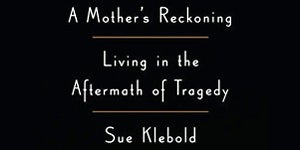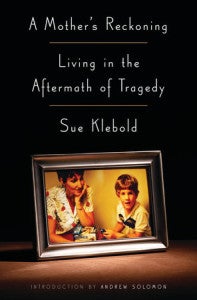Three Questions for an Editor: Crown’s Roger Scholl on A MOTHER’S RECKONING
May 12, 2016
 Roger Scholl, Vice President, Executive Editor, Crown Publishing Group, delves inside the acquisition, editing and impact of A MOTHER’S RECKONING: Living in the Aftermath of Tragedy by Sue Klebold, the mother of Columbine shooter Dylan Klebold.
Roger Scholl, Vice President, Executive Editor, Crown Publishing Group, delves inside the acquisition, editing and impact of A MOTHER’S RECKONING: Living in the Aftermath of Tragedy by Sue Klebold, the mother of Columbine shooter Dylan Klebold.
 What was involved in the acquisition of this book and key decisions about how to tell and structure this heart-breaking, tragic story?
I first heard of the book as the result of a lunch date with the agent, Laurie Bernstein, two years before the actual submission. Sue Klebold’s story, and message, sounded so unique, and so important, that I followed up periodically to express continued interest. Laurie gave me a heads up a week before she sent it out, and I alerted our publisher and the rest of our team that it was coming in, so that we would read and act quickly. The proposal came in the Thursday evening of BEA; I was expected at a reunion party, but I never made it – I was glued to my desk and my computer. The proposal, over 100 pages in length, was stunning — and pitch perfect in conveying Sue and her family’s experiences, and her ultimate message. And we made a pre-emptive bid for the book by noon the next day.
How would you describe the editor/author editorial process and what were some of the most challenging and rewarding points during the creation of A MOTHER’S RECKONING?
Sue had been teamed with a wonderful writer for the book, Laura Tucker. The proposal was so taut, so nuanced, and so well constructed that my real task as an editor with the manuscript was to ensure that we maintained the same high level of narrative pacing, detail, insight and candor that Sue and Laurie had originally achieved with the proposal. We did a good deal of back and forth to tighten the narrative, and made a few key decisions about structure and order, as well as about the level of detail Sue included in the book about the events at Columbine High School that morning, so that readers unfamiliar with the details of the tragedy would have a clearer picture of exactly what took place – and what Dylan, Sue’s son, and Eric Harris, did.
What do you and Ms. Klebold hope readers will derive most from reading and discussing this book?
I think that for Sue, this book has been a mission. She has spent every day of her life since the shootings trying to understand how the sweet young boy that she knew Dylan to be could have done what he did; why she was unable to see the signs beforehand; what she might have done differently to prevent the tragedy. The media wanted to paint Dylan as a monster. But the truth, she knew, was in some ways even more disturbing. He grew up in a loving, engaged home, had many friends, and although he was shy and perhaps spent too much time on his computer, he came across as a normal teenager, a boy who had just gone to senior prom and had been accepted to his first choice college. Her husband, Tom – they are now divorced – and her surviving son Bryon, were deeply opposed to her writing the book; it was just too painful a memory, and one I think they did not want to live through again. But Sue persevered because she felt that by telling her story, and the story of Dylan, she could reach out to parents and kids who were suffering emotionally or psychologically, and at risk, and in doing so potentially prevent a future Columbine from taking place, or prevent a child from hurting himself or herself, or someone else. Sue is donating the money she has received to charitable organizations, particularly those focused on mental health issues.
What was involved in the acquisition of this book and key decisions about how to tell and structure this heart-breaking, tragic story?
I first heard of the book as the result of a lunch date with the agent, Laurie Bernstein, two years before the actual submission. Sue Klebold’s story, and message, sounded so unique, and so important, that I followed up periodically to express continued interest. Laurie gave me a heads up a week before she sent it out, and I alerted our publisher and the rest of our team that it was coming in, so that we would read and act quickly. The proposal came in the Thursday evening of BEA; I was expected at a reunion party, but I never made it – I was glued to my desk and my computer. The proposal, over 100 pages in length, was stunning — and pitch perfect in conveying Sue and her family’s experiences, and her ultimate message. And we made a pre-emptive bid for the book by noon the next day.
How would you describe the editor/author editorial process and what were some of the most challenging and rewarding points during the creation of A MOTHER’S RECKONING?
Sue had been teamed with a wonderful writer for the book, Laura Tucker. The proposal was so taut, so nuanced, and so well constructed that my real task as an editor with the manuscript was to ensure that we maintained the same high level of narrative pacing, detail, insight and candor that Sue and Laurie had originally achieved with the proposal. We did a good deal of back and forth to tighten the narrative, and made a few key decisions about structure and order, as well as about the level of detail Sue included in the book about the events at Columbine High School that morning, so that readers unfamiliar with the details of the tragedy would have a clearer picture of exactly what took place – and what Dylan, Sue’s son, and Eric Harris, did.
What do you and Ms. Klebold hope readers will derive most from reading and discussing this book?
I think that for Sue, this book has been a mission. She has spent every day of her life since the shootings trying to understand how the sweet young boy that she knew Dylan to be could have done what he did; why she was unable to see the signs beforehand; what she might have done differently to prevent the tragedy. The media wanted to paint Dylan as a monster. But the truth, she knew, was in some ways even more disturbing. He grew up in a loving, engaged home, had many friends, and although he was shy and perhaps spent too much time on his computer, he came across as a normal teenager, a boy who had just gone to senior prom and had been accepted to his first choice college. Her husband, Tom – they are now divorced – and her surviving son Bryon, were deeply opposed to her writing the book; it was just too painful a memory, and one I think they did not want to live through again. But Sue persevered because she felt that by telling her story, and the story of Dylan, she could reach out to parents and kids who were suffering emotionally or psychologically, and at risk, and in doing so potentially prevent a future Columbine from taking place, or prevent a child from hurting himself or herself, or someone else. Sue is donating the money she has received to charitable organizations, particularly those focused on mental health issues. Popular Company News
Former First Lady Michelle Obama to Publish THE LOOK With Crown Publishing Group
June 5, 2025
The Crown Publishing Group today announced THE LOOK, a new book from Michelle Obama, former First Lady of the United States, to be published November 4, 2025.…
PRH Acquires Wonderbly, One of the UK’s Fastest-Growing Independent Publishers and Leader in Personalized Gift Books
June 4, 2025
Acquisition Underscores Penguin Random House’s Commitment to Innovation and Growth Penguin Random House, a leading global trade book publisher, has acquired Wonderbly, one of the UK’s…
PYR to Publish New Book Based on Most-Watched Bluey Episode Ever
May 6, 2025
Penguin Young Readers is delighted to announce that it will be publishing BLUEY: THE SIGN, a special hardcover children's book based on the record-breaking 28-minute Bluey…
Three PRH Authors Win Esteemed Pulitzer Prize
May 6, 2025
On Monday, May 5, three Penguin Random House authors were honored with a Pulitzer Prize. Established in 1917, the Pulitzer Prizes are the most prestigious prize…
Matthew McConaughey, Academy Award-Winning Actor and Author of GREENLIGHTS, to Publish New Book With Crown
June 26, 2025
Crown, an imprint of the Crown Publishing Group, announced the September 16 publication of POEMS & PRAYERS by Matthew McConaughey, an eternal optimist, Academy Award–winning actor,…
Legendary Thriller Author Frederick Forsyth Passes Away at 86
June 10, 2025
Frederick Forsyth, bestselling author, British RAF pilot, and journalist died on Monday, June 9, 2025. He wrote eighteen espionage thrillers including THE DAY OF THE JACKAL, THE…
PYR to Publish New Book for Tweens Inspired by the #1 NYT Bestseller, THE ANXIOUS GENERATION
May 21, 2025
Rocky Pond Books, an imprint of Penguin Young Readers, will publish a companion to social psychologist Jonathan Haidt’s #1 New York Times bestselling and culturally transformative…
Tiny Reparations Books Celebrates Their 5th Anniversary and Publication of Tourmaline’s MARSHA
June 4, 2025
On May 22, Tiny Reparations Books celebrated two momentous occasions: the 5th anniversary of the imprint and the launch of the National bestseller MARSHA, Tourmaline’s highly anticipated biography…
Companhia das Letras Recognized in Folha De S. Paulo’s Best Brazilian Books of the 21st Century
June 9, 2025
Folha de S. Paulo, a renowned Brazilian daily newspaper founded in 1921, recently released an issue celebrating the most noteworthy Brazilian literature of the 21st century. …
